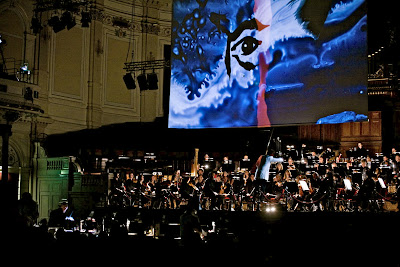How do you act like a legend?
Any tips?
Painting to Hamlet (Shostakovich) with the Netherlands Philharmonic, Amsterdam Concertgebouw. "To be, or not to be....?"
Leafing through the
Netherlands Chamber Orchestra’s new brochure for the 2013/14 Season, I found
the announcement of the concert Cloud and
Light (Bach and Hosokawa) on October 26th, where I shall flood the stage of the Muziekgebouw with
the projected colours of my live kinetic painting. The high point of my fluid
visual music might well be Toshio Hosokawa’s piece Meditation, music that mourns the victims of the tragic Japanese
earthquake and tsunami in Fukushima, two years ago last week. My work has long
been influenced by Japanese art and music and I am thrilled to be involved in this
performance.
But I was quite amused to discover in the blurb for this concert a reference to “the already legendary artist Norman Perryman”. Huh? You mean he’s still alive? This year I turn eighty and my contemporaries are dropping like flies – so maybe that’s what they’re referring to, with a nod to the respect for senior citizens that we find in Japanese culture. I tend to apply the term legendary to those already passed away, like Pavarotti, Bernstein, Toscanini – the dead about whom we pass on legends, contrived or real. These days, with the right PR, you can become a legend at 21, so is it all a big joke? Or is this PR department helpfully easing my way into that "other world" of legends? "Hey, remember that guy who was crazy enough to paint in time to the music in concerts?" Nah, that's a myth. "No really, he used analogue projectors too, really old school."
I can't help smiling. "To be, or not to be....". After all these years, I suppose I really do have quite a few stories to tell and thousands of pictures to share…but wait, I'm just getting going!
I've come from a very humble background (as illustrated in my blog: Early memories of an artist-to-be) and possess the British talent for self-deprecating humour, so superlatives of this kind tend not to be taken seriously, or might even become something of a family joke. Worse still, my son Chris is an actor. With his sense of humour, at the drop of a hat, I bet he will lovingly caricature me pretending to be “legendary”. And in Holland, where I now live, it's definitely not cool to be a legend. The common expression is: "Just act normal - that's crazy enough". The only guy allowed to be a legend is the footballer Johan Cruijff, and nowadays even he is considered to be rather pretentious.
Luciano Pavarotti. Now, this guy’s a legend.
But to answer my own
question in the headline: just be yourself and keep breathing to a grand old age, I guess. And keep
painting, of course. For me it’s the same as breathing. Oh, and you'll understand by now that this headline was written with tongue in cheek. I'm taking it all with a pinch of salt.





